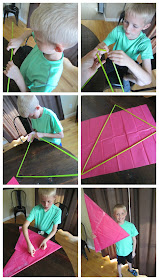One of the themes I planned to explore this summer was flight. This topic requires no selling from me; my two sons are instantly fascinated.
We recently visited both of the Smithsonian's Air and Space Museums in the Washington, D. C. area. Touring these museums and seeing my children's enthusiasm and wonder bumped this theme to the top of the list.
Because aviation truly took off after the successful flight of a glider, launching our own exploration of flight with a homemade glider seemed fitting.
What You Need
2 large sheets of tissue paper
8 drinking straws (the kind WITHOUT the bendy joint)
Clear plastic tape
How to Make It
Gently crimp one end of a straw and push it into another straw about an inch. Do this so you have three straws put together. Put another three straws together. Put the remaining two straws together.
Bend the top of one of the the three-strawed lengths down about two inches. Crimp the end of the other three-strawed length and push it into the end of the straw you bent. Your straws will form a V-shape.
The two-straw length will be the bottom of your triangular glider frame. Bend corners and push the straws together until you have a large isoceles triangle made of drinking straws.
Lay this over one piece of tissue paper. Wrap it around the frame and tape in place. It can either go completely around or just around one side. We covered the whole frame, both sides, and used two pieces of tissue to do so.
Every seam or loose flap of tissue was taped down to avoid creating any unwanted aerodynamic drag.
How to Fly It
Take the glider to an elevated place and propel it forward. It may take a few tries to figure out just where to grip it and how much force to use when releasing it. Watching it gracefully fly is both shocking and fun.
The gliders we made held up for a good 30 minutes of repeated flights, which given the construction, was pretty impressive. A little repair and we'll be back at it again tomorrow probably!
How Does a Glider Work
Because real gliders don't have an engine to help them fly either, their success in the air is largely dependent on their design. Both air flow and the wing design are what enable gliders to stay in the air despite their weight.
Our homemade glider is a delta wing airfoil and like all gliders, even hang gliders, its flight is made possible by Bernoulli's Principle. (Check out our exploration of Bernoulli's Principle here.) Essentially, the air moves faster over the top of the airfoil because of its design, which creates a low-pressure zone over the top. This enables the glider to be lifted, therefore suspending it in air.
Read a Book
My 9-year-old really enjoyed reading about the Wright Brothers' glider designs in Gerry Bailey's historical fiction book.
This wonderful craft came from Smash! Crash! Launch! 50 Mind-Blowing, Eye-Popping Science Experiments by Rain Newcomb and Bobby Mercer.




How neat. This is such an amazing idea.
ReplyDeleteI definitely want to try this with my kids.
ReplyDelete